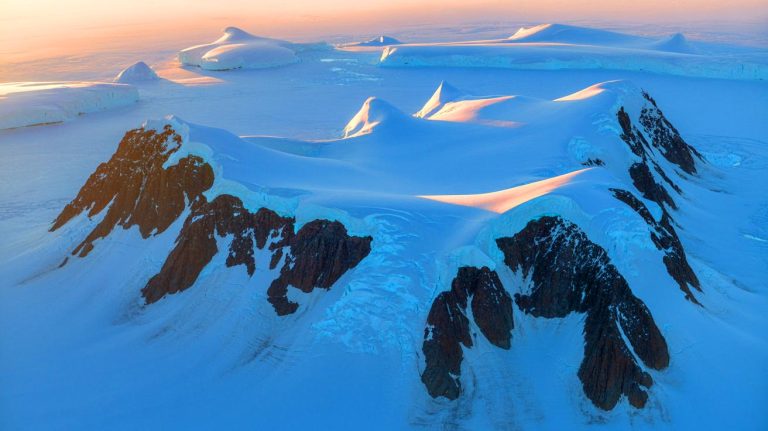| IN A NUTSHELL |
|
Antarctica, the vast and enigmatic continent, continues to captivate scientists with its hidden treasures beneath the ice. One of its most fascinating features is the ancient Transantarctic Mountains, a range stretching over 2,175 miles. These mountains play a pivotal role in influencing the ice flow and thickness across the continent. As researchers delve deeper into this icy frontier, they are uncovering stories of past climates and geological activity that could reshape our understanding of Earth’s history. The discoveries made beneath the Antarctic ice are not only intriguing but also critical to predicting how this remote region might respond to future climate change.
A Natural Barrier Beneath the Ice
The Transantarctic Mountains, concealed beneath layers of ice, act as a natural divide between two geologically distinct regions. To the east lies a stable craton, over a billion years old, juxtaposed against the active rift system in the west. This division has been instrumental in shaping the continent’s geological evolution over time. These mountains have undergone numerous cycles of erosion and uplift, as evidenced by rock samples analyzed by scientists. These samples reveal a history of mountain-building events closely tied to tectonic movements.
Through the use of thermochronology, researchers have dated these geological occurrences, uncovering periods of intense activity that align with major glaciation events approximately 300 million years ago. The study of these ancient formations offers a window into the dynamic processes that have sculpted Antarctica’s landscape. Such research provides valuable insights into the past and future of this frozen continent, shedding light on the intricate dynamics that have shaped its icy facade.
The Influence of Mountains on Ice Flows
Though hidden from view, the Transantarctic Mountains serve as invisible guides for the flow of glaciers. Their peaks and valleys channel these massive ice rivers, dictating their speed and accumulation. Understanding this interaction between rock and ice is crucial for grasping the evolution of polar ice caps. Recent findings suggest the existence of an even older mountain chain beneath East Antarctica. Gravimetric and magnetic anomalies hint at its ancient origins, dating back to a time when Earth’s climate was dramatically different.
These concealed formations provide clues about past climates, as evidenced by fossilized trees emerging from retreating ice. These remnants speak of a warmer Antarctica, long before its current icy state. Such discoveries are essential for reconstructing the continent’s climatic history and predicting how it might respond to future environmental changes. The interplay between these ancient mountains and the ice sheets above them is key to understanding global sea levels and climate patterns.
Unveiling Geological Mysteries Through Modern Science
The study of the Transantarctic Mountains and other hidden geological formations in Antarctica is not just about understanding the past; it is a testament to the power of modern science. Techniques such as thermochronology and gravimetric analysis allow scientists to peer into the deep history of our planet. By examining mineral samples, researchers can piece together a timeline of tectonic activities and glaciation cycles.
These scientific endeavors underscore the dynamic and ever-changing nature of Earth’s geology. As researchers continue to explore these ancient formations, they are not only unearthing the secrets of Antarctica but also expanding our understanding of Earth’s geological processes. The implications of this research extend far beyond the icy continent, offering insights into the forces that have shaped our planet over millions of years. This knowledge is crucial for predicting how these processes might influence future geological and climatic events.
The Impact of Discoveries on Climate Understanding
Antarctica’s buried geological features are more than just scientific curiosities; they hold significant implications for our understanding of climate change. The interplay between these ancient mountains and the ice sheets above them can influence global sea levels and climate patterns. As scientists uncover more about these hidden features, they gain a better grasp of how Antarctica’s ice might behave in a warming world.
The discovery of fossilized plant life and other evidence of past climates helps scientists develop models to predict future changes. These insights are critical for preparing for the potential impacts of climate change. As research continues, the question remains: How will the secrets of Antarctica’s hidden world influence our understanding of global climate dynamics?
As we continue to unravel the mysteries beneath Antarctica’s ice, the knowledge gained not only enriches our understanding of Earth’s past but also prepares us for the future. The ancient mountains and their hidden stories are integral to piecing together the planet’s climatic history and forecasting its future. Yet, as researchers dig deeper, one question persists: In what ways will these discoveries shape our approach to climate change and its impending challenges?
Did you like it? 4.6/5 (27)






